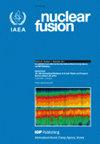Damage evolution in Plasma Facing Materials by a sequential multiscale approach
IF 4
1区 物理与天体物理
Q1 PHYSICS, FLUIDS & PLASMAS
引用次数: 0
Abstract
Describing the time evolution of Plasma Facing Materials (PFMs), through quantitative evaluations of erosion, roughness, and physical properties degradation, is one of the difficult challenges to reach the goal of efficient energy production by nuclear fusion. To follow all the aging-connected physical and chemical phenomena through their characteristic dimensional scale, and to estimate the PFM microstructural transformation over time, we propose a predictive sequential multiscale methodology, consisting of two database-provided coupled codes. The first is a time-dependent, volume-averaged, plasma simulator which describes completely this system in terms of thermodynamics, composition and evaluation of the sheath potential. Plasma solutions are geometrically rearranged by adding surface reactions and 3D geometric features. To increase sensitivity, plasma information is provided to the second code as an initial condition. Such a code is a 3D kinetic Monte Carlo in-cell algorithm for the nano-scale erosion simulation describing the PFM interactions through an extendable set of physical phenomena, such as sticking, sputtering, ion enhanced removals and ion penetration. In this paper, we perform simulations for the case of study of Hydrogen (H) plasmas produced in linear devices, reaching the quasi-atomic detail of the plasma induced material modification of tungsten (W) as PFM.用顺序多尺度方法研究等离子体面层材料的损伤演变
通过对侵蚀、粗糙度和物理性质退化的定量评估来描述等离子体表面材料(PFM)的时间演化,是实现核聚变高效能源生产目标的艰巨挑战之一。为了通过其特征尺寸尺度跟踪所有与老化相关的物理和化学现象,并估算 PFM 微结构随时间的变化,我们提出了一种预测性顺序多尺度方法,该方法由两个数据库提供的耦合代码组成。第一个是随时间变化的、体积平均的等离子体模拟器,它从热力学、组成和鞘势评估等方面完整地描述了这一系统。等离子体解决方案通过添加表面反应和三维几何特征进行几何重排。为了提高灵敏度,等离子体信息作为初始条件提供给第二个代码。这种代码是用于纳米尺度侵蚀模拟的三维动力学蒙特卡洛单元内算法,通过一组可扩展的物理现象(如粘滞、溅射、离子增强清除和离子穿透)来描述 PFM 的相互作用。在本文中,我们以线性设备中产生的氢(H)等离子体为研究案例进行了模拟,达到了等离子体诱导的作为 PFM 的钨(W)材料改性的准原子细节。
本文章由计算机程序翻译,如有差异,请以英文原文为准。
求助全文
约1分钟内获得全文
求助全文
来源期刊

Nuclear Fusion
物理-物理:核物理
CiteScore
6.30
自引率
39.40%
发文量
411
审稿时长
2.6 months
期刊介绍:
Nuclear Fusion publishes articles making significant advances to the field of controlled thermonuclear fusion. The journal scope includes:
-the production, heating and confinement of high temperature plasmas;
-the physical properties of such plasmas;
-the experimental or theoretical methods of exploring or explaining them;
-fusion reactor physics;
-reactor concepts; and
-fusion technologies.
The journal has a dedicated Associate Editor for inertial confinement fusion.
 求助内容:
求助内容: 应助结果提醒方式:
应助结果提醒方式:


